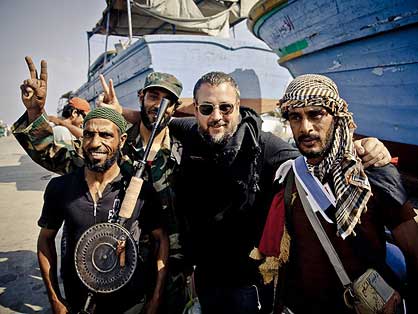
Vice is a brash, Brooklyn-based magazine and international media company, but mostly it’s a brand of thinking and marketing that has extended itself over the past decade to a popular website and YouTube channel with bureaus around the world.
Vice makes as much news as it reports; a recent foray involved the Vice crew bringing Dennis Rodman to North Korea to meet with Kim Jong Un.
There’s nothing Vice won’t cover or turn into a stunt – culture, news, war, sex, music, drugs – and it seems to do just fine without any assistance from the media establishment or the rules of old journalism.
And yet it wants a piece of that, too.
Vice, a fast and loose newsmagazine show debuting this week in the US, shoehorns the company’s sense of swagger into something that looks like traditional TV, setting out for the vast Third World to cover “the absurdity of the human condition.”
It’s a mutual exchange of fluids between old media and new, not unlike public radio’s This American Life’s attempt to flower into a Showtime series several years back.
Vice seeks to legitimise the Vice name for HBO viewers who have never heard of it.
By pure market value, Vice should have already become the Rolling Stone of its era, but many potential readers have learned to just get out of the way whenever we see it rolling our direction.
That’s mainly because the Vice voice can be off-putting.
Here, that voice sounds more mature. Hosted by Vice chief executive Shane Smith, Vice travels to the world’s most contentious and violent hot spots, mainly so that Smith or another correspondent can note that such places are indeed contentious and violent.
And here we are, at the center of it – where a bomb has just gone off, where children tote assault rifles and smoke cigarettes.
This is broadcast journalism for those who have not typically paid attention to foreign news and aren’t at all squeamish about seeing footage of war carnage that other networks might edit out as a matter of taste.
In the first episode, Smith heads to Afghanistan to report a story about boys recruited by the Taliban to act as suicide bombers.
Vice is a place to see all those severed hands and heads and other images we’ve typically been spared.
Smith is an enthusiastic mansplainer, reporting whatever he just learned as fresh news. “Obviously, he’s a cagey guy,” Smith says after an interview with a Taliban leader.
Watching Vice, I was reminded of a priceless scene from the 2011 documentary Page One, about the future of the New York Times, in which David Carr, the Times’s media columnist, cut short Smith’s bragging that he had covered atrocities in Liberia while the New York Times wrote lifestyle stories about surfing.
“Before you ever went there, we’ve had reporters there reporting on genocide after genocide,” Carr told Smith in a calm but eviscerating mini-lecture.
“Just because you put on a [expletive] safari helmet and looked at some poop doesn’t give you the right to insult what we do.”
Vice, which counts Bill Maher and Fareed Zakaria among its producers, prides itself on an adventuresome Lonely Planet sense of naivete, figuring that the best stories it can tell are the ones where it puts its correspondents – who, judging from two episodes, all seem to be white, male, tattooed, horn-rimmed and whiskered – at a relative amount of risk.
Ad Feedback
The problem here isn’t objectivity, which is itself an outdated way to describe fairness in reporting; the problem is that Vice seems plenty earnest but insufficiently skeptical, favouring outrage and shock over context and depth.
It is journo-tourism for hipsters, with an attitude that sometimes makes it difficult to appreciate the value of the stories being told.
And there is value here. Correspondent Thomas Morton travels to Laos to interview young women who escaped North Korea and are now in danger, we are told, of being forced into the sex trade.
The reporter accompanies a South Korean church pastor who hires a boat to sneak the refugees across the Mekong River into Thailand.
Everyone here is at risk of arrest or worse and, as the boat moves across the river in total darkness, it’s a moment that is both informative and thrilling.
Other reports, such as correspondent Ryan Duffy’s trip to a Philippine militia’s training camp filled with pre-teen recruits and black-market firearms, are top-heavy with attempts to pack in as much information as possible yet maintain a bromantic smoothness to the narrative flow.
(When the camp’s general clutches Duffy’s hand during a tour of the camp, the correspondent jokingly confesses it calmed his nerves.)
Vice” seems to be in search of some sweet spot between 60 Minutes and Jackass, and there’s enough here to prove that such a spot may exist. The concept could work, especially if Smith and his correspondents were more inclined to point the cameras away from themselves.
-Washington Post